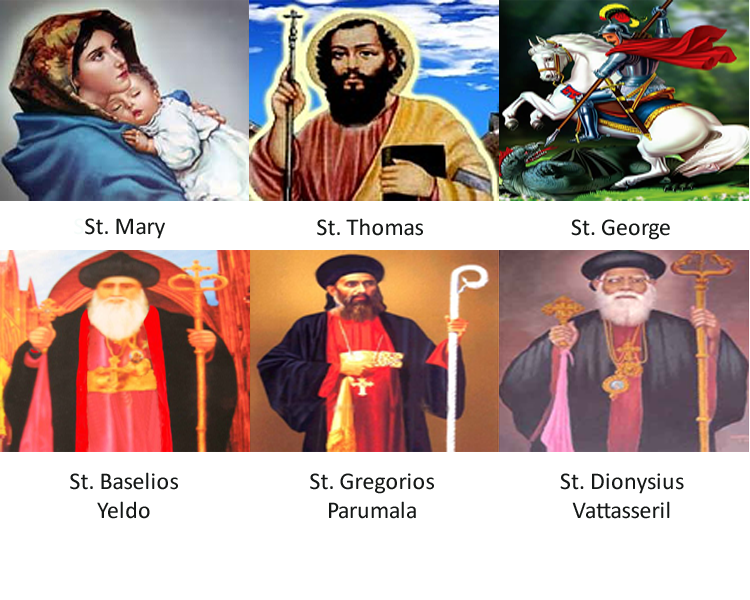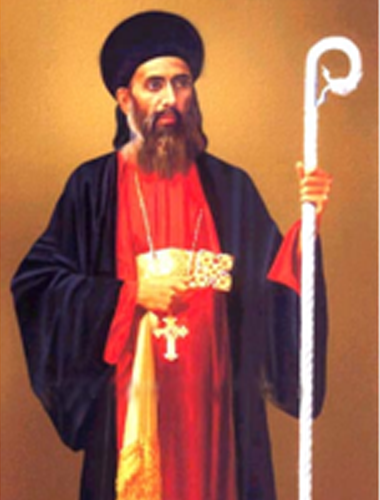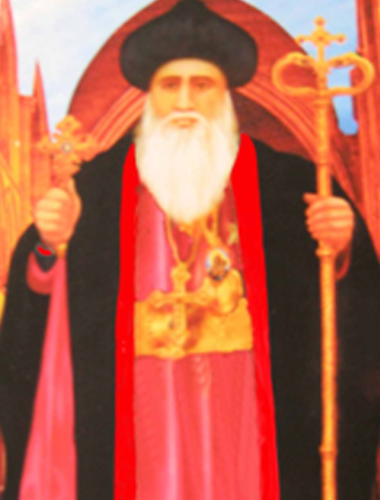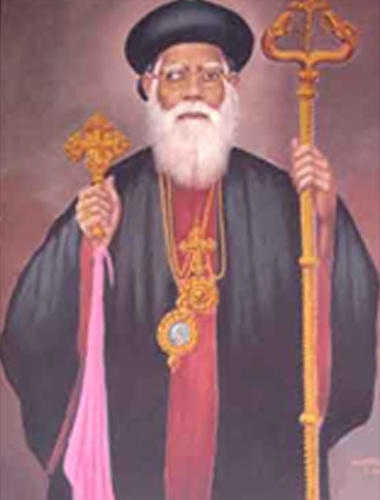

Saint Gregorios of Parumala is popularly known as ‘ParumalaThirumeni’. Metropolitan Geevarghese Mar Gregorios of the Malankara Orthodox Church who passed away on November 2nd 1902, became the first declared saint from Malankara (Kerala, India) naturally to be called, ‘ParumalaThirumeni’. He shines in the cloud of witnesses as a bright luminary giving rays of hope to millions in their suffering and struggles.
Mar Gregorios was born on 15th June 1848 (M.E. Mithunam 3, 1023) to KochuMathai and Mariam of Pallathetta family in the Chathuruthy house at Mulamthuruthy. He was called by the name ‘Kochaippora’ and was given the baptismal name ‘Geevarghese’. Kochaippora had two brothers and two sisters; Kurian, Eli, Mariam and Varkey. Kochaippora was the youngest and was therefore the most beloved to everyone. Unfortunately, his mother passed away when he was only two years old. His eldest sister Mariam became to him all that a mother was meant. Mariam was married at that time and had a child of Kochaippora’s age.
He was ordained as a reader-deacon (Korooyo) on 14th Sept, 1858 at the age of ten by Palakkunnath Mathews Mar Athanasios at Karingachira Church. KoroyoGeevarghese continued his training under GeevargheseMalpan until the latter died due to small pox. Although Deacon Geevarghese was also infected with small pox, he miraculously survived it. Afterwards Deacon Geevarghese moved to Pampakuda to continue his studies under KonatGeevargheseMalpan. In the meantime Deacon became associated with the visiting Syrian Bishop Yuyakim Mar Coorilos. Mar Coorilos had great admiration for the deacon and was pleased to ordain him as full deacon, priest and cor-episcopa within few months in 1865.
The new priest’s short stay at MulanthuruthyMarthommen Church gave him an inner conviction that he should lead a hermit’s life in a quieter place. Therefore he shifted his residence to VettickalDayara. At VettickalDayara, CorepiscopaGeevarghese started a strenuous life of prayer and fasting. Having heard about the vigorous asceticism practised by corepiscopaGeevarghese, the then Malankara Metropolitan Pulikkottil Joseph Mar Dionysius made him a ‘Ramban’ (Monk Priest) in 1872.
In 1876, the Antioch Patriarch His Holiness Peter III visited Malankara. The Patriarch chose RambanGeevarghese as his Secretary and translator during the entire visit. Along with the Patriarch, the Ramban visited many churches. RambanGeevarghese also assisted the Patriarch in the consecration of the Holy Mooron and in the historic synod of Mulanthuruthy in 1876.
Being pleased with the RambanGeevarghese, the Patriarch decided to consecrate him as Metropolitan. On December 10, 1876 the Patriarch consecrated six priests as bishops including RambanGeevarghese at St. Thomas Church, N Paravur. He was given the new name Geevarghese Mar Gregorios and was given the charge of Niranam Diocese. The other bishops and their Diocese were:
Mar Gregorios was only 28 years when he was made a bishop. Since he was the youngest among all the bishops, he was dearly called by all as ‘KochuThirumeni’. The first thing the new bishops undertook was a special fasting-vigil for forty days at VettickalDayara under the leadership of ‘KochuThirumeni’. This fasting was both symbolic and effective in the pursuit of new life in an old church.
Mar Gregorios took charge of the Niranam Diocese and started staying at Parumala. There was at Parumala, at that time, a land donated by ArikupurathKoruthMathen to the church and in this plot a small building was erected by the Malankara Metropolitan Pulikkottil Joseph Mar Dionysius. This building was known as ‘Azhippura’. Mar Gregorios lived there along with few other deacons who came for priestly training. They worshipped in a thatched chapel during that time.
Mar Gregorios engaged in a threefold activity of tireless service for the church: Diocesan administration, Ministerial formation of deacons, Missionary witness of the church through inner spiritual and theological consolidation, along with evangelical reaching out.
In addition to these, Mar Gregorios undertook the task of building a church and seminary at Parumala. The diocesan administration, in the meantime, was extended to two more dioceses, Thumpamon and Quilon. The newly constructed church was consecrated in 1895. Mar Gregorios was the co-celebrant for the consecration of two ex-Roman Catholic priests as bishops: Fr.Alvaris as Alvaris Mar Julius for Bombay-Mangalore Diocese; Fr.ReneVilatti as Rene Vilatti Mar Timotheos for America.
Mar Gregorios made the Holy Land Pilgrimage in 1895 as the fulfillment of a long cherished dream. On his return he published a travelogue under the title ‘Oorslemyathravivaranam’ (a narrative of the Jerusalem visit). This book, published in 1895 is to be considered as the earliest printed travelogue in Malayalam. This book had its centenary edition in 1996 and translation into English in 2000.
Mar Gregorios believed that the church should engage in educational activity especially to facilitate primary education and English teaching without discriminating gender or religion. Accordingly he started schools at Kunnamkulam, Mulamthuruthy, Niranam, Thumpamon, Thiruvalla etc. The missionary task of the Church was also evinced by his outreach programme to the socially down trodden communities at Chennithala, Kalikunnu, Mallappally, Puthupally, Kallumkathara etc. He also organized evangelical awakening programme for non-Christians at various places like Aluva, under the leadership of the Seminary students.
A major task of Mar Gregorios was to motivate the clergy for effective ministry. With this aim, he formed the Malankara Syrian Clergy Association and took many progressive decisions and made many suggestions for the effective functioning of the priestly ministry.

St. Yeldho Mar Baselios was born in a village called kooded (now known as Karakosh) near Mosul in Iraq where Morthsmooni and her 7 children suffered martyrdom. At a very young age he joined the Mar Bahnan Monastery and become a monk. In 1678 he was consecrated Catholicos by the Patriarch of Antioch Mar Ignatius Abdul Masih I. In 1685 at the age of 92, the Holy Father started the difficult mission to India at the request of Marthoma II of Malankara who informed the Patriarchate about the unpleasant situation of the Church here.
The saintly Maphryono was accompanied by his brother, two monks and an Episcopo, but only three of them are believed to have reached Malankara. The saint expired on Saturday afternoon on 'Kanni 19' (Malayalam Calendar), 1685 and was entombed on the very next day in the sanctuary of Mar ThomaCheriapally, Kothamangalam. Though the Holy Father had lived in this land for only a few days, his name has spread far and wide leaving a lasting mark in the history of Malankara Church.
YeldhoMar Baselios and his entourage reached Surat in Gujarat (North India) by the middle of 1685 and from there proceeded to the Malabar coast. Sometime later, they landed at Thalassery port in North Malabar. [As per the letter of MarThoma IV to the Patriarch of Antioch dated 25th Elool (Sept) 1720, those who reached Malabar, were Mar BaseliosYeldho, Mar Ivanios, and 'RambanMathai' (there exists no further information about this Ramban)]. In order to avoid attacks from pirates along the seacoast and to escape from the Portuguese, they traversed due east to Tamil Nadu and proceeded down to southern Kerala on foot. Obviously the saint and others with him were under the impression that the Portuguese were still wielding power on the west coast. So the journey was in disguise through thick forests. After some weeks they reached a small village on the bank of a river at sunset. On the way they encountered a ferocious tiger. Bava’s escorts were scared to death but it is said that the Saint calmly took out the 'Sleeba' (Cross) and made the sign of the cross in the direction of the animal and it ran away roaring into the forests as if struck by a heavy object.
Later they reached the place which is now known as 'Pallivasal' near Munnar. There were many huts in the foothills for the travellers. Mar BaseliosYeldho had a feeling that it would be dangerous to stay in those inns since he expected heavy rains and floods that night. So the Saint advised his companions and the people remaining in the place that it would be better to sleep on the upper reaches of the surrounding hills. Some people who believed him moved higher up the hill but others dismissed the idea lightly and stayed on the inns. During the night there was a very heavy downpour and in the instantaneous flood many people and animals living on the river banks lost their lives. In the morning the saint offered the Holy Qurbana (Holy Eucharist), for the dead and the mercy shown on those with him, on a temporary altar made there. From that time the place assumed the name ‘PALLIVASAL’ (place of Holy church). The site where he offered the Holy Qurbana is said to be considered sacred by the tribals of the hills around.
From there the Holy Father accompanied by the EpiscopaIvanios came to Kozhippilli village near Kothamangalam by afternoon. When they came to know that they had reached populated areas, the Saint decided that it was unwise for both to travel together any further. He therefore asked the Episcopa to climb a tree and hide himself while the Saint proceeded on foot for reconnaissance. When the Holy Father reached the banks of Kothamangalamriver at Chakkalakudy he saw a Nair (Hindu) Gentleman who was tending cattle there. Through symbols they communicated and the man told the Saint that there was a Church nearby. The Saint asked him to accompany him to the church. The man expressed his inability to do so since he could not abandon the cattle. The Saint took his walking stick and drew a big circle on the ground. Then he asked the man to take all the cattle into that circle. He waited for some more time to see how the cattle behaved and he found that they were not leaving the boundary of the circle. He realized that Mar BaseliosYeldho was a man of God. The man's sister was at that time in labor pains. He told the Saint about the difficult situation. When the Saint asked for some water with a view to bless it, the man thought that he was asking for water to quench thirst and he tried to climb a coconut tree nearby. The tree began to bend! The man took two tender coconuts from the tree and gave them to the Saint. The Saint blessed one of the tender coconuts and asked the man to rush home and make his sister drink the juice. While the Saint waited at the same spot, after about one hour the man returned with the good news that his sister had given birth to a boy. Greater surprise was in store for him, since the cattle had not moved out of the circle. The man gladly accompanied the Saint to the church. While they got into the river to cross it, some children who were swimming in the river tried to throw pebbles at the Saint. Somehow instead of throwing pebbles they ended up following the Saint and his companion.
The people of Kothamangalam celebrate the Cheriyapally festival on October 2 and 3 with piety and festivity. In remembrance to the instance of guiding Mar BaseliosYeldho to this church by a Nair (Hindu) Youth, his successors are still given the privilege to hold the traditional lamp of the church and lead the 'Rassa' (Church procession) to the church on the festival day of the Saint.
Canonization
St. Yeldho Mar Baselios is canonized on 2nd Nov 1947 by H.H BaseliosGeevarghese IICatholicos.

St. Dionysius was born to his parents, Joseph Vattasseril of Mallappally and EliammaKolathuKalathil of Kurichy on 31st October 1858. Following his elementary education at C. M. S. Middle School in Mallappally he completed his high school education from C. M. S. High School, Kottayam. In 1876, while still a high school student, he was ordained as a sub deacon by H. H. Moran Mar Pathrose Patriarch. Life in the Church
Dn. Geevarghese studied at the Orthodox Theological Seminary (Old Seminary or Pazhaya Seminary), Kottayam for four years thereby undergoing his theological training. Dn. Geevarghese soon became a great Syriac scholar under the careful tutelage of St. Gregorios of Parumala, who taught him at Seminary. In 1879 Dn. Geevarghese was ordained as a full deacon and in 1880 he was ordained as a priest by St. Gregorios. By 1880, Fr. Geevarghese had become an authority in the Syriac, Church History, Faith and Doctrine, the Church Fathers, and Theology. In recognition of his incredible expertise in Syriac and theology he was designated as MalankaraMalpan. He spent his spare time reading, studying, and thinking which translated to his many renowned writings such as “Doctrines of the Church”. He also used his scholarship to edit and publish the order of Church worship to be used by the ordinary faithful for meaningful participation in worship. He was appointed as Principal of M. D. Seminary, Kottayam as he was both a great scholar and administrator. In 1903, he was blessed as aRamban (monk). He also served as the Manager of Parumala Seminary. In 1908 he was consecrated as H. G. Geevarghese Mar Dionysius Metropolitan and served as the Assistant Malankara Metropolitan. The next year he became the Malankara Metropolitan and served and led the Church in that capacity until his departure from this life in 1934 when he and the Church triumphed in establishing the official constitution of the Malankara Orthodox Syrian Church.